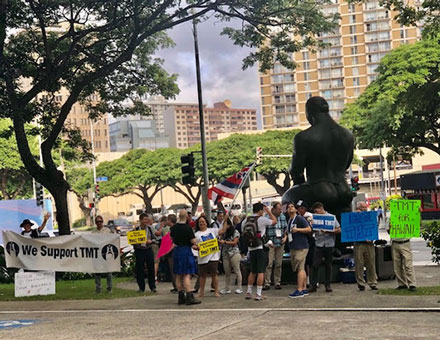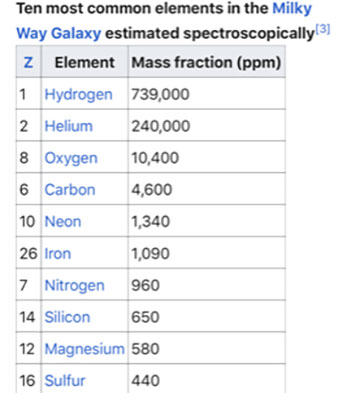Well it is another day in Hawaii at the 235th AAS meeting and the temptation to play hooky is very, very strong. Not because the meeting is not interesting, but because of the natural beauty of Hawaii.
But, I will resist a little bit more and offer some more brief summaries of interesting presentations. First up is some more activity on Twitter about more evidence that questions the key assumptions made in the determination of the need for dark energy. Hmm, this is at least two recent papers that challenge the assumptions made in supernova standard calendar calculations.
 |
| Is the basic assumption of dark energy in error? (Source: www.phys.org) |
So, I guess more data and analysis will be needed to resolve the dark energy controversy. We will have to wait and see on this issue. The authors of this paper made a presentation at the AAS, but unfortunately I had not put that event on my calendar, so I didn't pick up any of the discussion.
For me, I've never really liked dark energy. Ok, ok, so it is a great explanation that seems to fit the data, but no one has any compelling idea about what it actually is. For me, regardless of the actual outcome, this represents a good time to go back and revisit the GR representations of universes and see what happens to the equations when we just set the dark energy or the cosmological constant or whatever you want to call it, to zero. That should be a good review for the aspiring astrophysicist wannabe! Does this mean that the universe might just continue expanding forever, even if not accelerating, or will it be found to ultimately just slow down and fall back in a big crunch?
Another issue that we have to wait and see is whether the Thirty Meter Telescope (TMT) will be built on Mauna Kea or not. While we were at the 235th AAS meeting, there were groups of pro and con demonstrators outside the convention center. Here is a photo of the group who were demonstrating in favor of building the TMT in Hawaii. Do you recognize Ethan Siegel, with his back turned toward us, of "It Starts with a Bang"?
 |
| TMT Protests at Convention Center; This time pro demonstrators (Source: Palmia Observatory) |
Another controversy in the astronomical community is the impact of the hugely increasing number of satellite constellations planned for the next several years. Several speakers at the AAS meeting addressed two main issues. The first issue has to do with whether we will have any dark sky left at all with 1000's of new satellites whizzing around. One speaker said that we should not get too worried about the Starlink "string of pearls" because that configuration is, as we know, only temporary as the satellites propel themselves to higher and more dispersed orbits. The opinion expressed by one of the speakers, based on analysis of planned orbits, is that most of these satellites and planned new ones will not interfere with visual observers, at say 6th magnitude, except for an hour or so around sunset and sunrise. Ok, so we visual observers will not lose the night sky; so far so good. Professional astronomers will lose some of hours of observing time due to saturated sensors during some hours, again close to sunset or sunrise, due to sunlight reflecting off the satellites. On of the major launchers of these new constellation of satellites, planned to be in the 1000's is SpaceX and Patricia Cooper of SpaceX addressed the AAS with respect to ongoing plans to mitigate the brightness of the satellites.
 |
| Patricia Cooper, VP SpaceX, discusses astronomical mitigation for Starlink constellations at 235th AAS meeting (Source: Palmia Observatory) |
A separate plenary session addressed how the invention of astrophysics transformed astronomy. It used to be thought back in the 1800's that the future of astronomy was just going to be making more and more accurate measurements of planet's orbits and such measurements. But, as Robert Smith told us, all of that changed with the advent of astrophysics. Now there were so many other things to measure and questions to be answered. So, with the advent of astrophysics, the life of the astronomer changed from just making more and more accurate measurements of the motion of the stars and planets, to asking the big questions about how did get here, how to stars work, how to planets form, etc.
 |
| Robert Smith, U. of Alberta, on how it was astrophysics that transformed astronomy (Source: Palmia Observatory) |
The plenary session "Making a Habitable Planet" by Ed Bergin, got our interest by asking why life on our planet is mostly made out of water and carbon and yet the Earth itself is actually very poor in water, carbon and oxygen. These elements have the right chemical properties for life, but apparently don't have the right properties to be represented on the planet in the same proportion to the cosmological proportions.
 |
| Ed Bergin asks why is Earth a carbon, oxygen and water poor planet? (Source: Palmia Observatory) |
So, as a separate part of our homework we need to review what are the most common elements in the Milky Way? Well, by inspection of this Wikipedia chart, we see Hydrogen, Oxygen and Carbon are very abundant. But they are not all that common on planets. The Earth is no water world!
 |
| Cosmological abundance of elements (Source: Wikipedia) |
So now we can come back to Professor Bergin's point and look at why planets are so poor in these major elements that populate the Milky Way. This was his way to start to talk about the astrophysics and geophysics of planet formation. It all has to do with how the protoplanetary disks around new young stars is formed and how the elements begin to get segregated due to their condensation temperatures. There are two primary stages where the composition of planets begins to differ from the composition of the protoplanetary disk. First, we know that the temperature variation as you move inward toward the protostar is a key factor. Secondly, as planets form, gravitational sedimentation leads to higher concentration of the heavy iron components. He also talked about how comet's compositions match the early universe and studying comets tells us a lot about the history of the early Milky Way. These kinds of processes are well covered in your standard planetary sciences textbook.
 | |
|
I also sat in on some of the more technical sessions like some of those presented by the History of Astronomy Division (HAD) of the AAS. I especially enjoyed some of the sessions that dealt with the history of interferometry and stellar imaging. Maybe I can comment about those topics latter after I have a chance to review some of the details.
Another HAD presentation was made by Virginia Trimble, UCI, and whenever she is speaking, I usually try to attend. Even though she needs to use a walker now, she does not seem to have slowed down much. She is such a dedicated scholar and at the particular session that I sat in on, her presentation was on the historical debate between Curtis and Shapley, and others, on the size of the universe. So, Virginia told us a lot of the details of the debate and introduced other major characters into this drama, but I was fading fast. I am somewhat used to Virginia's style of presentation, and in this case, she got into more details than I could keep in mind.
 |
| Virginia Trimble, UCI, talks about the history of size of the universe Curtis-Shapley debate (Source: Palmia Observatory) |
Ok, so after all of those historical details, I was left powerless to my hooky playing impulses and I met up with Resident Astronomer Peggy and took the afternoon off and we signed up for a submarine ride. This submarine is a real submarine that drops down to 100 feet underwater. So, we boarded a boat at the hotel dock and went offshore a mile or so where the submarine was just surfacing at the end of an earlier sea bottom tour. We watched as the submarine blew a circle of air bubbles indicating that it was about to surface. This photo shows the now alongside our boat and the two are lashed together as one group of tourists gets off the sub and our group then goes aboard the sub.
 |
| Looking down at our submarine ties up alongside (Source: Palmia Observatory) |
The submarine has large viewing windows and we got a pretty good view of the underwater world. We moved between several artificial reefs that were installed there. Some of the artificial reefs were hand constructed underwater or towed into position and some were old ships and airplanes. We saw several sharks, a lot of fish, and a couple of giant sea turtles. It was a fun way to get out in the water.
 |
| Resident Astronomer Peggy waits as the submarine dives to 100 feet (Source: Palmia Observatory) |
Back on shore, we found that it was fun just to take a relaxing walk along the beach. The weather was again fantastic, with temperatures in the mid to high 70's, and even when it rained a bit, the rain was warm and didn't last long. So, it was a nice way to spend the afternoon. No more astrophysics today!
 |
| Back on shore with Diamond Head in the background (Source: Palmia Observatory) |
So, at the end of a 1/2 day of astronomy and 1/2 day of hooky, we ended the day with a fun dinner at the nearby Japanese steak house. We had a nice evening meal and shared our table with some wonderful guests from Australia, who have been on travel for a month now.
Wow, can those chefs really handle their knives and keep all the meats and vegetables in the right kind of motion. Here you can see the chef at the Rocky Japanese Steak Teppan Restaurant, after slicing, flipping and stacking some onion pieces, then light the whole structure on fire for a volcano effect. Pretty neat! It was a lot of fun and the food was fantastic and the colorful island drinks were a big help too!
 |
| Enjoyed the island cocktail and the Japanese chef, knives and all (Source: Palmia Observatory) |
Until next time, Aloha!
Resident Astronomer George
Be sure to check out over 300 other blog posts on similar topics
If you are interested in things astronomical or in astrophysics and cosmology
Check out this blog at www.palmiaobservatory.com

No comments:
Post a Comment